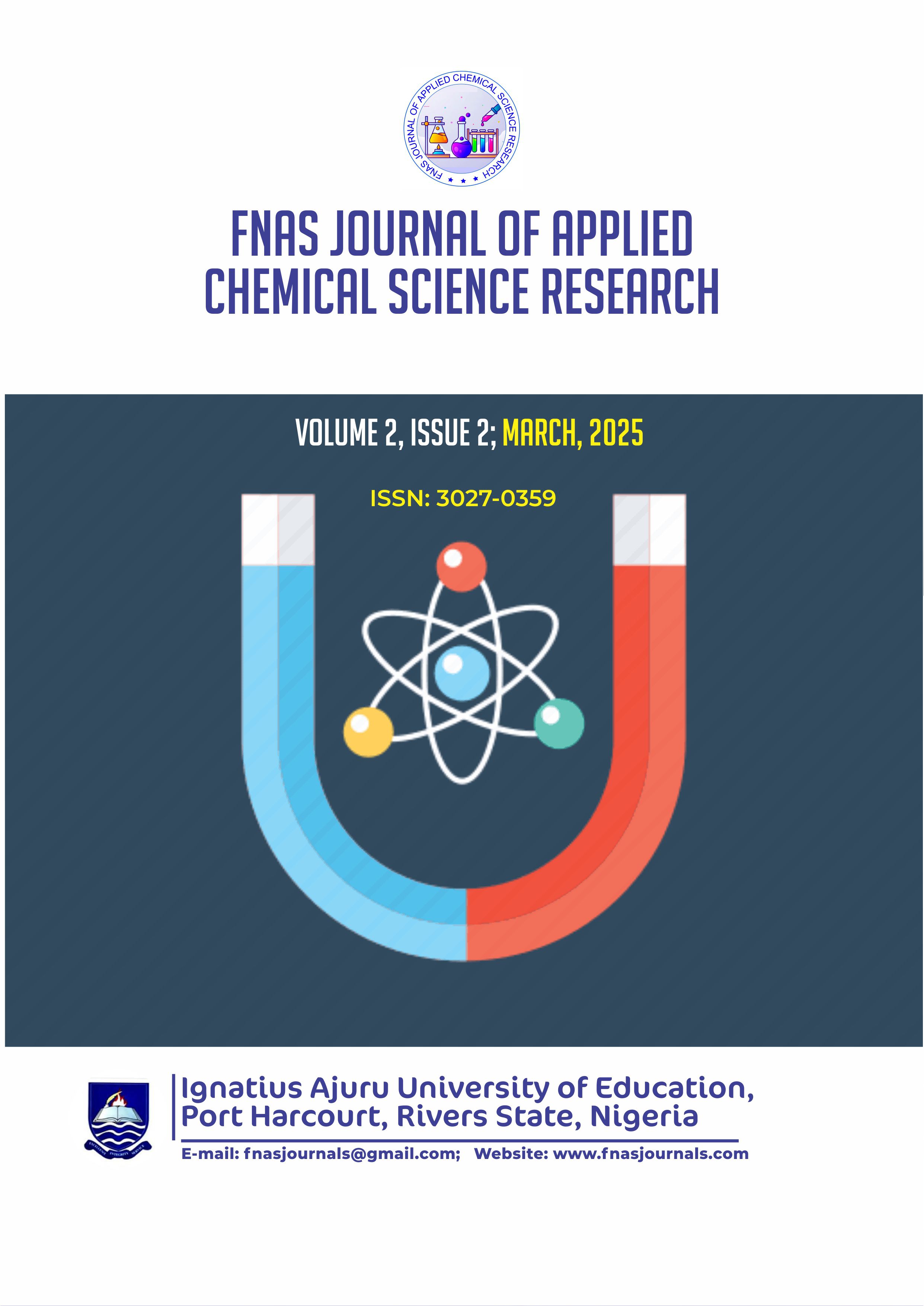Synthesis, Characterization and Antimicrobial Properties of Metal-based Tosylamides
Keywords:
Bioactivity, Metal Complexes, Tosylamide, Synthesis, Antimicrobial PropertiesAbstract
As a group of pharmaceuticals, the metal complex of heterocyclic tosylamide derivatives is one of the most extensive classes in medicinal chemistry; its members are employed in the treatment of infections, diabetes, inflammation, and neurological diseases. This work explored the synthesis, characterisation, and antibacterial activity of tosylamide metal complexes. Further steps involved synthesising and recrystallising the ligand's Co (II) and Ni (II) complexes in suitable solvents. Melting point and thin layer chromatography were employed to ascertain the purity levels. To better understand the complexes and ligands, we used ESI-MS, FTIR, and NMR to get structural details. The fact that specific absorption bands in the infrared spectra of tosylamide derivatives moved to higher or lower wave numbers in the complexes proved that there was azomethine nitrogen coordinating with the metal ion. The produced ligand and its metal complexes were evaluated for their antimicrobial properties against several species of E. coli, Bacillus, Salmonella, Penicillium, and Candida. Some coordinated ligands shown even higher efficiency against these diseases, yet the ligand and its complexes were effective against the selected bacterial and fungal strains. In comparison to common antibacterial drugs like tetracycline and nystatin, the produced chemicals showed reduced sensitivity.
References
Abdul-Qadir, M., Ahmed, M., Aslam, H., Waseem, S., & Shafiq, M. I. (2015). Amidine sulfonamides and benzene sulfonamides: Synthesis and their biological evaluation. Journal of Chemistry, 2015(1), 524056. Al-Shaheen, A. J., & Al-Bergas, A. F. (2020). Synthesis and identification of some complexes of 4-[N-(2, 4-dihydroxybenzylidene) imino] antipyrinyl with serine (L1) or with theronine (L2) ligands and evaluation of their bacteria activities. J. Educ. Sci, 29(4), 42-61. Chebout, O., Trifa, C., Bouacida, S., Boudraa, M., Imane, H., Merzougui, M., ... & Merazig, H. (2022). Two new copper (II) complexes with sulfanilamide as ligand: Synthesis, structural, thermal analysis, electrochemical studies and antibacterial activity. Journal of Molecular Structure, 1248, 131446. Chen, Y. L., Sharma, P., & Liu, R. S. (2016). Sulfonamide-directed gold-catalyzed [2+ 2+ 2]-cycloadditions of nitriles with two discrete ynamides to construct 2, 4-diaminopyridine cores. Chemical Communications, 52(15), 3187-3190. Chohan, Z. H. (2008). Metal-based sulfonamides: Their preparation, characterization and in-vitro antibacterial, antifungal & cytotoxic properties. X-ray structure of 4-[(2-hydroxybenzylidene) amino] benzenesulfonamide. Journal of Enzyme Inhibition and Medicinal Chemistry, 23(1), 120-130. Clayden, J., Greeves, N., & Warren, S. (2012). Organic chemistry. Oxford University Press, USA. Deng, X., & Mani, N. S. (2006). An efficient route to 4-aryl-5-pyrimidinylimidazoles via sequential functionalization of 2, 4-dichloropyrimidine. Organic Letters, 8(2), 269-272. Ebosie, N. P., Ogwuegbu, M. O., Onyedika, G. O., & Onwumere, F. C. (2021). Biological and analytical applications of Schiff base metal complexes derived from salicylidene-4-aminoantipyrine and its derivatives: A review. Journal of the Iranian Chemical Society, 18(12), 3145-3175. Fernández, J., Bert, F., & Nicolas-Chanoine, M. H. (2016). The challenges of multi-drug-resistance in hepatology. Journal of hepatology, 65(5), 1043-1054. Hashempour-Baltork, F., Hosseini, H., Shojaee-Aliabadi, S., Torbati, M., Alizadeh, A. M., & Alizadeh, M. (2019). Drug resistance and the prevention strategies in food borne bacteria: an update review. Advanced pharmaceutical bulletin, 9(3), 335.
Heravi, M. M., Amiri, Z., Kafshdarzadeh, K., & Zadsirjan, V. (2021). Synthesis of indole derivatives as prevalent moieties present in selected alkaloids. RSC advances, 11(53), 33540-33612. Lakrout, S., K'tir, H., Amira, A., Berredjem, M., & Aouf, N. E. (2014). A simple and eco-sustainable method for the sulfonylation of amines under microwave-assisted solvent-free conditions. RSC Advances, 4(31), 16027-16032. Mfuh, A. M., & Larionov, O. V. (2015). Heterocyclic N-oxides-an emerging class of therapeutic agents. Current medicinal chemistry, 22(24), 2819-2857. Ndagi, U., Mhlongo, N., & Soliman, M. E. (2017). Metal complexes in cancer therapy–an update from drug design perspective. Drug design, development and therapy, 599-616. Orie, K. J., Ngochindo, R. I., & Abayeh, O. J. (2019). Synthesis of 1, 1-bis (2-carbamoylguanidino) furan-2-ylmethane. Journal of Chemical Society of Nigeria, 44(2). Orie, K. J., Duru, R. U., & Ngochindo, R. I. (2021). Synthesis and complexation of monotosylated 4-aminopyridine with Nickel (II) and Iron (II) Ions. Makara Journal of Science, 25(3), 6.
Nna, P. J., Legborsi, J. and Orie, K. J. (2020). Comparative Study on the Phytoconstituents and Antimicrobial Analysis of Jatropha curcas Leaf and Stem Bark. Direct Res. J. Chem. Mater. Sci. Vol. 7(3), Pp. 37-43. Patil, S. A., Halasangi, B. M., Toragalmath, S. S., & Badami, P. S. (2014). Thermal, physico-chemical, in vitro anti-microbial and DNA cleavage investigations of newly synthesized Co (II), Ni (II) and Cu (II) complexes of O, N donor Schiff base. DER PHARMA CHEMICA, 6(3), 261-271. Priya, B., Utreja, D., Sharma, S., Kaur, G., & Madhvi. (2023). Synthesis and antimicrobial activities of indole-based Schiff bases and their metal complexes: a review. Current Organic Chemistry, 27(11), 941-961. Samper, K. G., Marker, S. C., Bayón, P., MacMillan, S. N., Keresztes, I., Palacios, Ò., & Wilson, J. J. (2017). Reprint of “Anticancer activity of hydroxy-and sulfonamide-azobenzene platinum (II) complexes in cisplatin-resistant ovarian cancer cells”. Journal of inorganic biochemistry, 177, 335-343. Shamle, N. J., Tella, A. C., Obaleye, J. A., Balogun, F. O., Ashafa, A. O., & Ajibade, P. A. (2020). Synthesis, characterization, antioxidant and antidiabetic studies of Cu (II) and Zn (II) complexes of tolfenamic acid/mefenamic acid with 1-methylimidazole. Inorganica Chimica Acta, 513, 119942. Zhang, H., & Muñiz, K. (2017). Selective piperidine synthesis exploiting iodine-catalyzed Csp3–H amination under visible light. ACS Catalysis, 7(6), 4122-4125.


